[Note: I wrote this 25 years ago, reprinted here.]
June 3, 1998
This morning was little different at the office than other mornings. I am on the West Team of the Loudoun Region of the Hospice of Northern Virginia. The West Team occupies one room on the second floor of a two-story townhouse office in Leesburg.

Hank at Grief Camp for Children, 1998
Now, get this picture. On the West Team are five nurses, three social workers and one chaplain. In our room are six desks and five phones. No desks are assigned. First-come, first-served. We do not spend a lot of time in the office because we mainly are on the road visiting patients. Yet, most of us start our day there. Can you see where this is going?
I got there a little late today and I was lucky. I got a desk but, alas, it was the one without the phone. It does have a view — into the back yards of townhouses. I am close to my colleagues — Kelly was about two feet to my left and Pam equidistant to my right.
We all talked about Nelia, who had to pull her hair back because she was going to see Sara who didn’t like Nelia’s hair falling in her face as she cared for Sara. We are part of each other’s conversations, each other’s space, each other’s work lives.
Ordained June 3, 1973
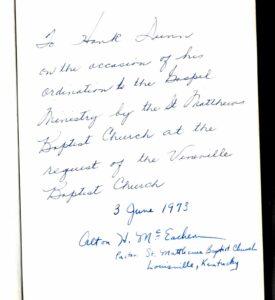
Hank’s ordination Bible, 1973
It struck me this morning, and I announced to my friends at work, I was ordained to the gospel ministry twenty-five years ago today. It took place at the St. Matthews Baptist Church in Louisville, Kentucky on the same weekend as my graduation from seminary. The pastor who led the service left Louisville to pastor the largest church in North Carolina. He called me a year later and asked if I would come to be his youth minister. I didn’t. He eventually left the ministry. Something about an affair. Last I heard he was selling cars.
And me? After twenty-five years in the ministry? I have made it all the way to — sharing phones, sharing desks, views of townhouse backyards and having to turn in a time sheet every day with my documentation or I don’t get paid.
“Success” in the ministry
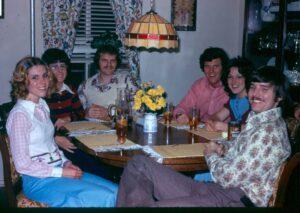
Hank (right) with seminary friends. In this photo are two future seminary presidents, one future pastor and one future hospice chaplain.
This is unlike one of my best friends during seminary days who went on to get a Ph.D. from Cambridge and is now president of the largest seminary in the world. Others from our class pastor big churches. I report to the senior social worker who reports to a vice president who reports to a president who reports to a board of directors. I am pretty far down on the food chain.
Here I am, a fifty-year-old, making less than many new college graduates earn. I have come all this way in the ministry, following my call only to find myself doing what any seminary student could do. I don’t know. I’m not feeling sorry for myself. I was just struck with the irony of the celebration of the 25th anniversary of my ordination and having to borrow a phone to make a call.
I think probably my classmates and I all imagined as we left seminary that in twenty-five years, we would have a private office with a secretary or at least a phone. That’s how we keep score in our society — how much money I make; how much of the trappings of success do I have, like a beautiful office; how many employees I supervise; or, what kind of car I drive.
Less is more
But, you know — this lack of having an office is so much better. I have had to narrow my essential papers down to two notebooks that I can carry anywhere. If I had an office, I would have piles of clutter everywhere. And not having an office says to me my work is not at a desk anyway — it is with the people — and sick and dying people at that.
I think I remember something Jesus said about foxes having holes, yet the Son of Man has nowhere to lay his head. I guess Jesus didn’t have an office either.
Hank
_________________________
Chaplain Hank Dunn is the author of Hard Choices for Loving People: CPR, Feeding Tubes, Palliative Care, Comfort Measures and the Patient with a Serious Illness and Light in the Shadows. Together they have sold over 4 million copies. You can purchase his books at hankdunn.com or on Amazon.

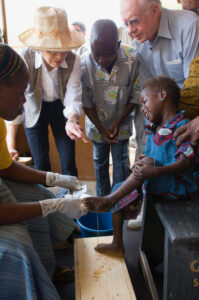

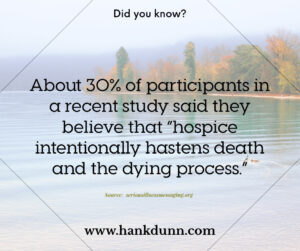 I posted a
I posted a 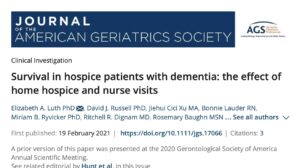 It makes no sense that hospice would want to hasten a patient’s death. The more days the patient is on hospice, the more reimbursement the hospice receives. It is totally against their financial interest to hasten death.
It makes no sense that hospice would want to hasten a patient’s death. The more days the patient is on hospice, the more reimbursement the hospice receives. It is totally against their financial interest to hasten death.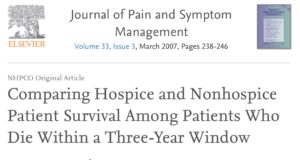 Many studies confirm that hospice patients live longer than nonhospice patients suffering from the same disease.
Many studies confirm that hospice patients live longer than nonhospice patients suffering from the same disease.  Rosemary Bowen, at 94, was living independently. She said she had had a wonderful life and did not look forward to a long, slow decline toward death. For years, she had been telling her children, “That her life would not be worth living if she had to depend on caretakers to feed her, dress her, and take her to the toilet.” Then, it happened. She fractured her back and went to rehab but was unable to live independently. That was enough for her.
Rosemary Bowen, at 94, was living independently. She said she had had a wonderful life and did not look forward to a long, slow decline toward death. For years, she had been telling her children, “That her life would not be worth living if she had to depend on caretakers to feed her, dress her, and take her to the toilet.” Then, it happened. She fractured her back and went to rehab but was unable to live independently. That was enough for her.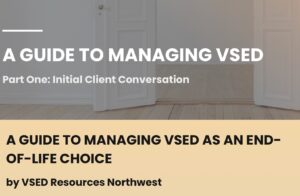 Do not try this without medical support. Rosemary was able to get a hospice to care for her in her last days. Palliative care is also available to ease burdensome symptoms like pain and thirst. See
Do not try this without medical support. Rosemary was able to get a hospice to care for her in her last days. Palliative care is also available to ease burdensome symptoms like pain and thirst. See  How many times have we seen in an obituary, “He died peacefully at home with his family gathered around him.” Families wear this as a badge of honor. They provided the best of care and met the patient’s wishes to remain at home.
How many times have we seen in an obituary, “He died peacefully at home with his family gathered around him.” Families wear this as a badge of honor. They provided the best of care and met the patient’s wishes to remain at home.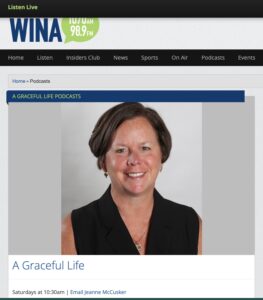
 Another change in the last 40 years has been the increased use of advance directive documents like living wills and durable powers of attorney for healthcare. About half the adult population now has such papers.
Another change in the last 40 years has been the increased use of advance directive documents like living wills and durable powers of attorney for healthcare. About half the adult population now has such papers.
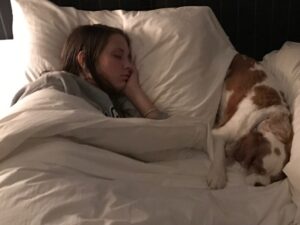 “Charlie” was not a very creative name, but it just seemed to fit a male King Charles Spaniel. At first, we crated him at night. After weeks of barking, he finally settled into his crate and his place at home. Until…
“Charlie” was not a very creative name, but it just seemed to fit a male King Charles Spaniel. At first, we crated him at night. After weeks of barking, he finally settled into his crate and his place at home. Until… Charlie joined Katie in Oxford her second year at Ole Miss, where he supported her during roommate issues and dating cycles. Their deep bond reached new depths. A dog just loves unconditionally.
Charlie joined Katie in Oxford her second year at Ole Miss, where he supported her during roommate issues and dating cycles. Their deep bond reached new depths. A dog just loves unconditionally.

 On Sunday afternoon, my wife and I were pulling into the Walmart parking lot, and she blurted out, “Katie has to come home tonight.” It was a mother’s flash of insight for her soon-to-be grieving daughter. She called Katie and told her to get to National airport and get on a plane. I picked her up in Memphis with Charlie a few hours later. They slept together on our bedroom floor that night before she returned to D.C., Monday. In the car on the way to the Memphis airport, she “Snapped” a photo to friends, “my last photo I’ll ever take with my baby.” Indeed, it was.
On Sunday afternoon, my wife and I were pulling into the Walmart parking lot, and she blurted out, “Katie has to come home tonight.” It was a mother’s flash of insight for her soon-to-be grieving daughter. She called Katie and told her to get to National airport and get on a plane. I picked her up in Memphis with Charlie a few hours later. They slept together on our bedroom floor that night before she returned to D.C., Monday. In the car on the way to the Memphis airport, she “Snapped” a photo to friends, “my last photo I’ll ever take with my baby.” Indeed, it was.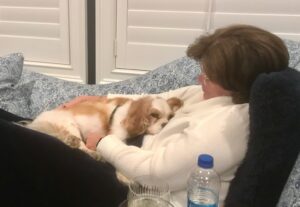
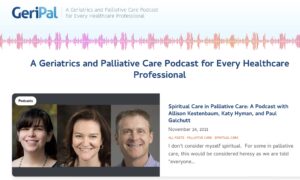 A
A 
